When you think of ancient Greek paintings, what comes to your mind?
I personally would think of grandeur, Greek gods and magnificence!
And that is exactly what I got during my research on ancient Greece art!
From architecture, to wall paintings, vase paintings, sculpture making and other paintings, Greek paintings have a special place in the history of painting!
Did you know that the oldest Greek art is traced back to 540- 530 BCE?
These paintings were made in panels, which were made out of shaped wooden pieces, which were polished and painted.
Historians who have studied the Greek period had also stated how panel drawings were considered the most respectable form of art during the time.
Did you know? These paintings were often made using tempera and encaustic wax!
Because of these mediums used, a lot of them were perished and unfortunately could not withstand the effects of time.
It is possible that we, being in the world of modern art, may not be aware of the Greek art mythology or the drawings from the period.
In this blog, I am going to take you through 10 selected famous Greek paintings whose brilliance will leave you spellbound!
Table of contents
1. The Ladies Fresco

Do fresco paintings ring a bell?
Yes, they were the most commonly used art technique in medieval artwork!
Among our list of ancient Greek paintings, we are going to cover the Akrotiri fresco paintings which were found long after the land was submerged due to a volcanic eruption.
So, then how did mankind come to know about these Greek paintings?
There was one good thing that came out of the calamity, everything got covered and because of this, stayed preserved until they were excavated!
One such traditional Greek painting is The Ladies fresco!
This painting is divided into two, depicting two, high society women, wearing rich clothes, adorned with jewelry and makeup!
As you can see, the painting is not in the best shape, but we can almost make out a third figure in this Greek drawing!
Also Read: Medieval Art: The Dramatic Art of the Middle Ages
2. The Spring Fresco
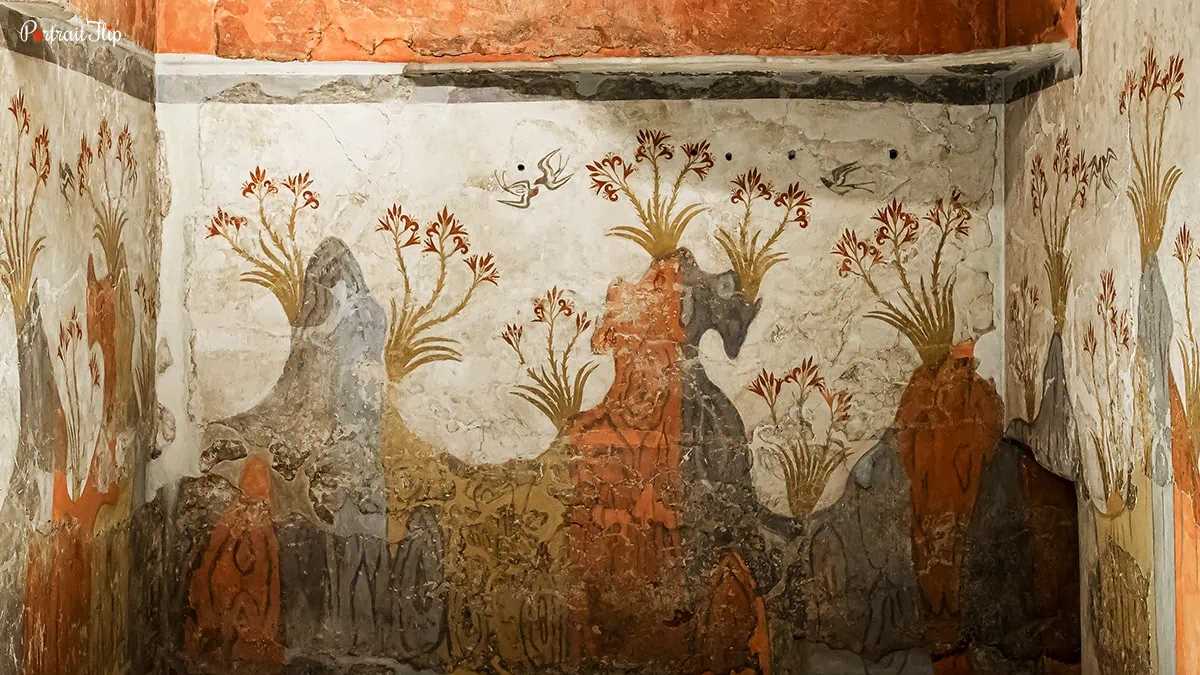
This is yet another 16th century ancient Greek painting that was found at Akrotiri.
The Spring fresco is believed to be the depiction of spring, where the painting shows trees and plants between what seems like volcanic rock beds.
The way the plants are painted in this famous Greek painting, it depicts motion, almost like the plants are swaying with the wind.
Because of the context of spring it holds, it is also called the Lilies or Papyrus fresco!
3. The Boxers Fresco

Now this particular fresco art from ancient Greek painting is quite interesting!
We have two young men involved in the act of boxing in this ancient Greece art!
This gives us an indication that boxing was a sport which was encouraged and practiced in the Greek era.
Historians found frescoes depicting antelopes around the walls of The Boxing fresco.
Notice the subjects in the painting— they have long hair with parts of their head shaved!
We can also see how one of the figures is wearing a lot of jewelry while the other is wearing none.
So, this could indicate their social status too!
With the antelopes around them, do you think the figures in combat were being compared to the antelopes?
Also Read: Paintings by Cleopatra
4. The Fisherman Fresco

Among the frescoes found in Akrotiri, The Fisherman fresco was the best preserved ancient Greek painting with the least damage.
The fresco is easy to interpret; it shows a man carrying the fish he caught, all bundled together!
The male figure seems to be naked, and yet again depicted with parts of their head shaved.
Because of their attire, historians have also proposed the theory theory that this was a part of some ritual that they followed at the time.
The reason for archeologists to come to this conclusion is also because the painting was found in a room where there was a ritualistic table!
Because of these findings, there is a high chance that the Greek painting depicts some religious offering or ritual!
Suggested Read: Famous Religious Paintings: The Enthralling Biblical Artworks
5. The Blue Monkeys Fresco
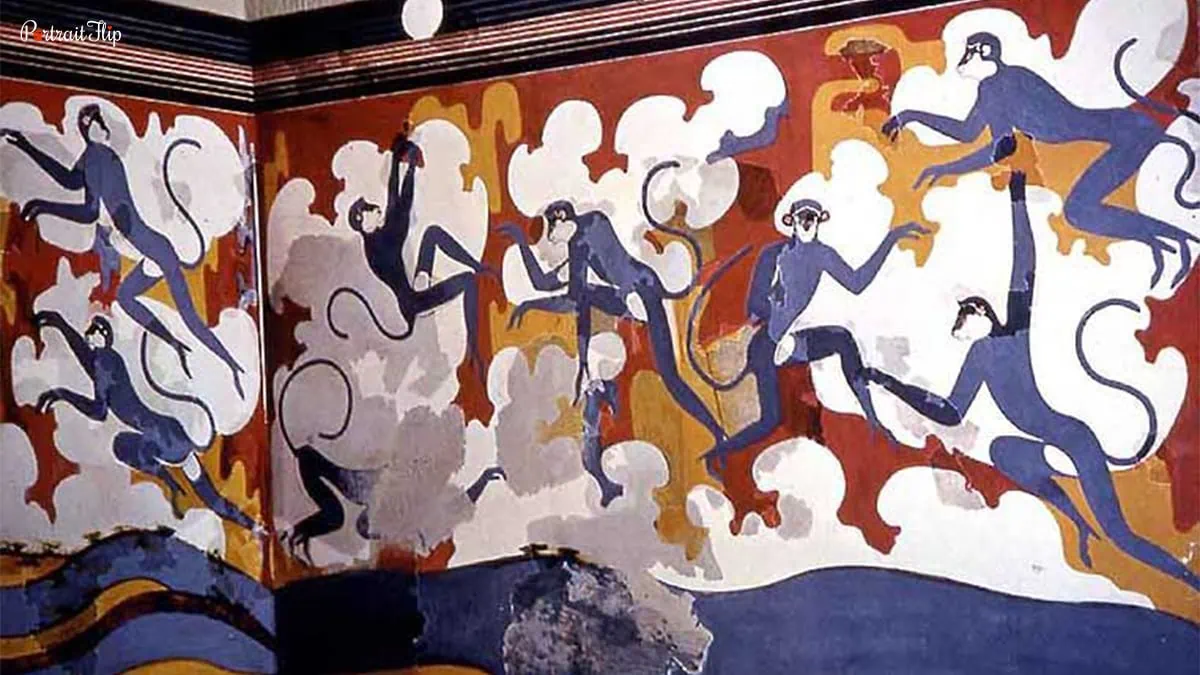
The last of the frescoes on our list of ancient Greek paintings is the Blue Monkeys fresco!
This one is a personal favorite because of the hues and a certain pattern used in the Greek artifact!
This pattern is created with several monkeys in the shade of blue.
Moreover they are seen jumping and climbing rocks to escape from two dogs.
In Greek art mythology, monkeys represent attendants or helpers of the priestesses of the Greek era.
This is again just a theory by the historians, because archeologists have also found fossils of real monkeys on Akrotiri island!
Suggested Read: Deconstructing Dutch Artwork
6. Pitsa Panels

The painting you are reading about now is known to be the oldest panel painting to ever exist in Greece!
This ancient Greek painting was found in the 1930s, in some old caves in Pitsa.
Because of the natural decay played by time, some of the panels were found in almost unattainable conditions!
When is it dated back to?
Archaeologists have found the painting to belong to the Greek archaic period, which is around 540 to 530 BCE.
Considering the panels were made from thin blocks of wood, they had still stormed through and survived the time to a great extent!
It was a pleasant surprise to find out that the hues used on the painting had also survived through all the years.
What do you see in the painting, though?
The paintings depict women, nymphs, musicians and other features that depict a story or a ritual of sacrifice!
7. Achilles and Ajax Playing
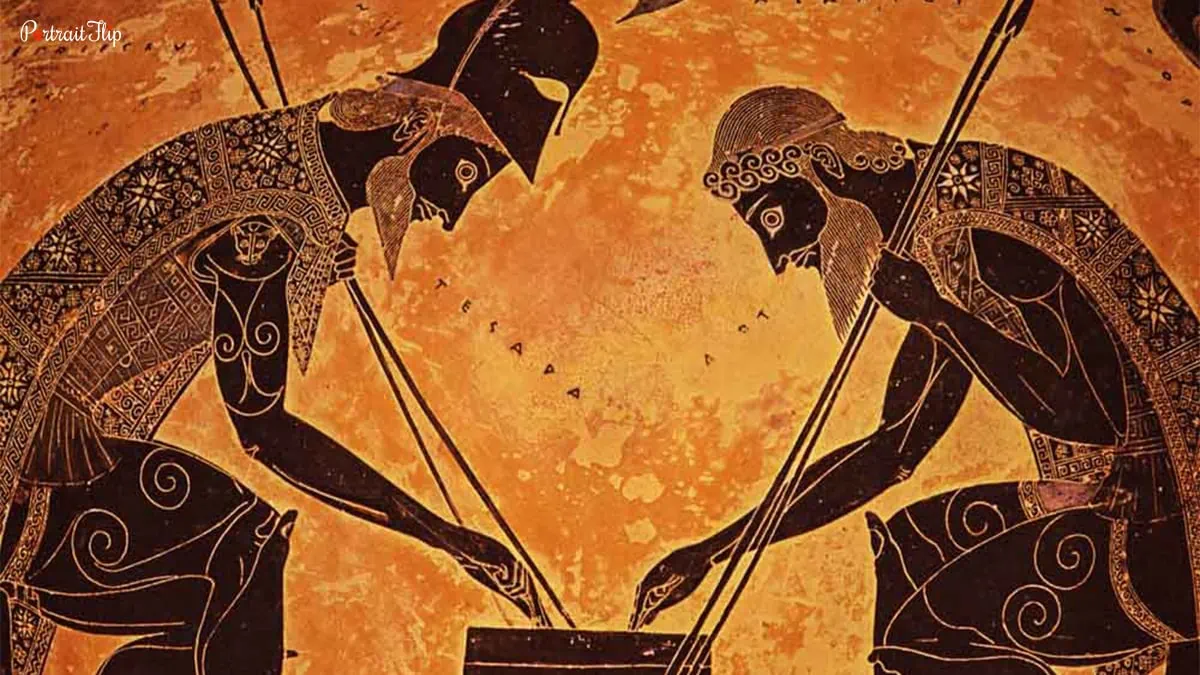
From our list of ancient Greek paintings, we now enter the vase paintings.
Here, we are also able to identify the artist behind the ancient Greek painting, Achilles and Ajax Playing!
The Greek artist, Exekias is considered to be one of the most brilliant Attic painters.
Because he was known for the intricate details he’d applied to his artworks, and his method involved complex incision techniques!
Exekias most common technique used in his artwork was the black-figure technique which gave impeccable results.
Now if you look at this Greek artwork itself, you’ll see two Greek legends sitting opposite each other, deeply involved in some kind of game!
What is interesting is that although they are playing a game, both the subjects are carrying weapons on them and are fully armed.
This could either depict that they are soldiers finding entertainment in a game and some even say that it depicts the Trojan War symbolically.
8. Euphronios Krater
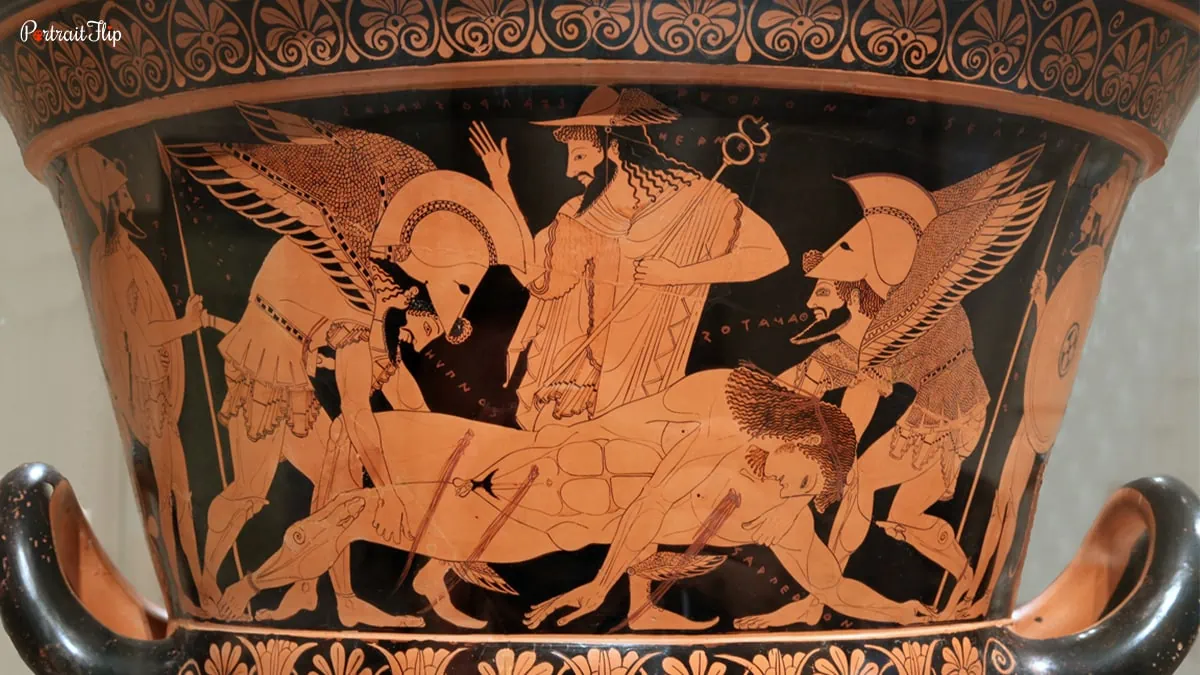
The Euphronios Krater is known to be one of the most exceptional vase paintings among ancient Greek art!
The name of the artist who created the vase painting is Euphronios!
There were a total of 27 vases in the collection he painted .
The vase painting, Euphronis Krater, shows several men getting themselves ready for the upcoming battle in Athens.
Everything on this particular piece of Greek art depicts the brilliance of the late Archaic Greek artists and art style!
9. Tomb of the Diver at Paestum
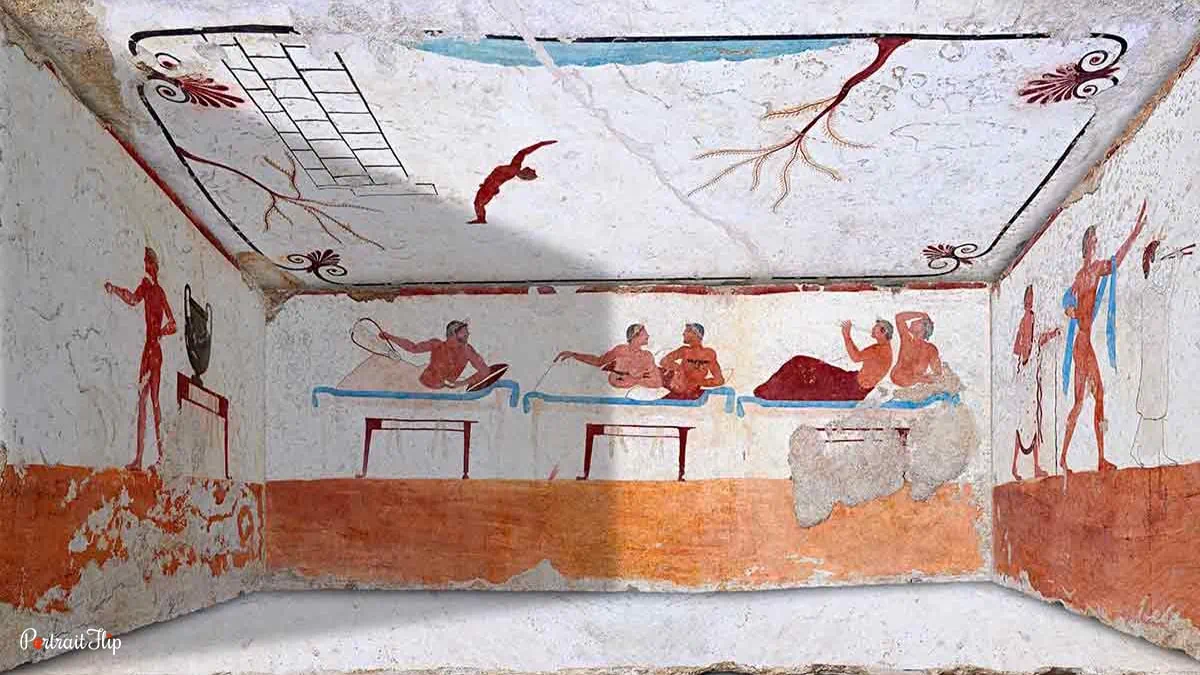
The artist of The Tomb of the Diver is unknown to this day but it was found in 1968 as one of the most archeological ancient Greece art!
This particular ancient Greek painting is a whole tomb!
What is interesting about this tomb is that its painted ceilings and the walls however the floor remained natural bedrock.
The tomb was made out of five limestone pieces and put together with plaster to create the tomb!
Did you recognize that the painting technique here again is fresco?-
This makes it even more special and rare!
If you noticed frescos are also infamous for their durability.
They have survived through centuries without getting damaged.
Because an attic vase was found in the tomb, archeologists concluded that the tomb was from around 470 BCE!
Suggested Read: Paintings of Cleopatra
10. The Siren Vase

How interested are you in painting mysteries?
Well, we have one from the Greek era too!
The artist of The Siren Vase was mysteriously named the “Siren Painter”, because there was a particular set of Attican vases made, but never signed.
That’s why this brilliant ancient Greek painting’s artist, their name, age and any details remain unknown to this day!
The painting on the vase depicts Odysseus’s ship passing with the sirens surrounding it.
The details of this painting are what makes it so mesmerizing.
Each of the figures on the ship, and the sirens around it are painted with precision.
Along with that, the details around the ship are also intricately portrayed!
Author’s Note
Hello Readers,
As we come to the end of this blog, I would like to thank you all for taking time to read it.
I hope this piece quenches your curiosity on some of the most famous ancient Greek paintings!
Feel free to reach out to us in the comments below!
Until the next one,
Cheers xx
Frequently Asked Questions
The period between 900 and 30 BCE is known to be the period ancient Greek art existed. This period was divided into 4 sections; Geometric, Archaic, Classical and Hellenist.
Ancient Greek art focused on the achievements and accomplishments of human beings from the different periods of the Greek era.
Fresco paintings were commonly used in ancient Greece art. Frescos were also great at being preserved as they could withstand the aging and damage through time.





